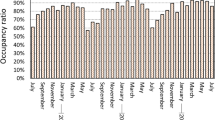Abstract
When a house is placed on the market, the seller must choose the initial offer price. Setting the price too high or too low affects the marketability of the property. While there is near universal agreement that the seller faces a trade-off between selling at a higher price and selling in less time, there is less agreement about how to measure this trade-off. This paper offers a framework for analysis and shows that an increase in the list price increases expected time-on-the-market (TOM). Because house buyers must solve a type of signal extraction problem, the effect of a higher list price is magnified for houses in a market segment having a low predicted variance of the list price. This paper also shows that the list price of houses which are withdrawn before sale has a higher mean and variance, and that the possibility of withdrawal censors information about the time-on-the-market.
Similar content being viewed by others
References
Anglin, Paul. (1994). “A Summary of Some Data on Buying and Selling Houses,” Working paper, University of Windsor.
Anglin, Paul. (1997). “Determinants of Buyer Search in a Housing Market,” Real Estate Economics 25, 567-590.
Anglin, Paul. (1999). “Testing Some Theories of Bargaining.” Working paper, University of Windsor.
Arnold, Michael A. (1999). “Search, Bargaining and Optimal Asking Prices,” Real Estate Economics 27, 453-482.
Blanchard, Oliver J., and Peter Diamond. (1989). “The Beveridge Curve,” Brookings Papers on Economic Activity 0(1), 1-60.
Forgey, Fred A., Ronald C. Rutherford, and Thomas M. Springer. (1996). “Search and Liquidity in Single-Family Housing,” Real Estate Economics 24, 273-292.
Glower, Michel, Donald R. Haurin, and Patric H. Hendershott. (1998). “Selling Time and Selling Price: The Influence of Seller Motivation,” Real Estate Economics 26, 719-740.
Haurin, Donald R. (1988). “The Duration of Marketing Time of Residential Housing,” Journal of the American Real Estate and Urban Economics Association 16, 396-410.
Kluger, Brian D., and Norman G. Miller. (1990). “Measuring Real Estate Liquidity,” Journal of the American Real Estate and Urban Economics Association 18, 145-159.
Knight, John. (2002). “Listing Price, Time on Market and Ultimate Selling Price: Causes and Effects of Listing Price Changes,” Real Estate Economics 30, 213-237.
Knight, John, C. F. Sirmans, and Geoffrey Turnbull. (1994). “List Price Signalling and Buyer Behavior in the Housing Market,” Journal of Real Estate Finance and Economics 9, 177-192.
Krainer, John. (2001). “A Theory of Liquidity in Residential Real Estate Markets,” Journal of Urban Economics 49, 32-53.
Lancaster, Tony. (1990). The Econometric Analysis of Transition Data. New York: Cambridge University Press.
Ong, Seow Eng, and Yen-Ching Koh. (2000). “Time-on-Market and Price Trade-offs in High-rise Housing Submarkets,” Urban Studies 37, 2057-2071.
Ortalo-Magne, Francois, and Antonio Merlo. (2000). “Bargaining over Residential Real Estate: Evidence from England.” Working paper, London School of Economics.
Springer, Thomas M. (1996). “Single-Family Housing Transactions: Seller Motivations, Price and Marketing Time,” Journal of Real Estate Finance and Economics 13, 237-254.
Taylor, Curtis R. (1999). “Time-on-the-market as a Sign of Quality,” Review of Economic Studies 66, 555-578.
Trippi, Robert. (1977). “Estimating the Relationship between Price and Time to Sale for Investment Property,” Management Science 23, 838-842.
Wheaton, William C. (1990). “Vacancy, Search and Prices in a Housing Market Matching Model,” Journal of Political Economy 98, 1270-1292.
Yavas, Abdullah. (1992). “A Simple Search and Bargaining Model of Real Estate Markets,” Journal of the American Real Estate and Urban Economics Association 20, 533-548.
Yavas, Abdullah, and Shiawee Yang. (1995). “The Strategic Role of Listing Price in Marketing Real Estate: Theory and Evidence,” Real Estate Economics 23, 347-368.
Zuehlke, Thomas W. (1987). “Duration Dependence in the Housing Market,” The Review of Economics and Statistics 701-704.
Author information
Authors and Affiliations
Rights and permissions
About this article
Cite this article
Anglin, P.M., Rutherford, R. & Springer, T.M. The Trade-off Between the Selling Price of Residential Properties and Time-on-the-Market: The Impact of Price Setting. The Journal of Real Estate Finance and Economics 26, 95–111 (2003). https://doi.org/10.1023/A:1021526332732
Issue Date:
DOI: https://doi.org/10.1023/A:1021526332732




